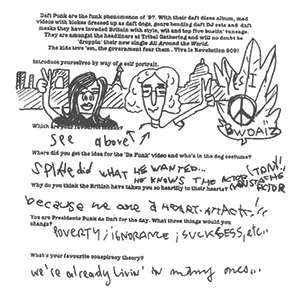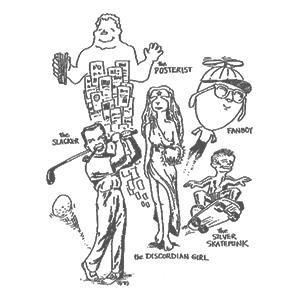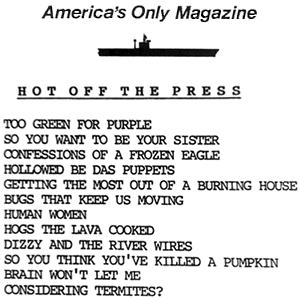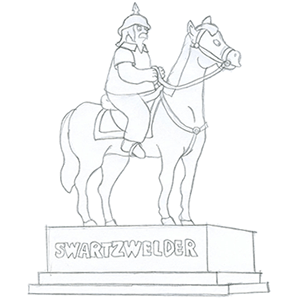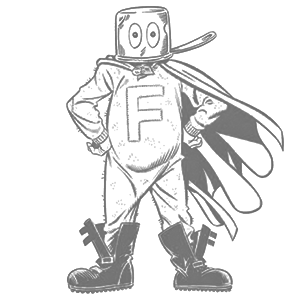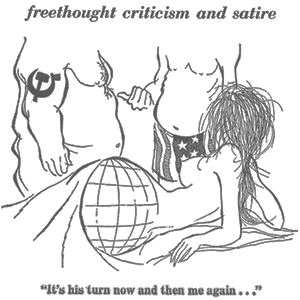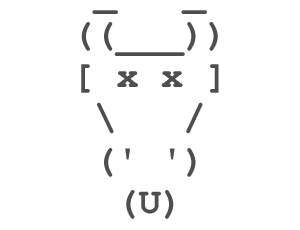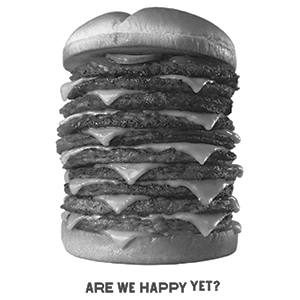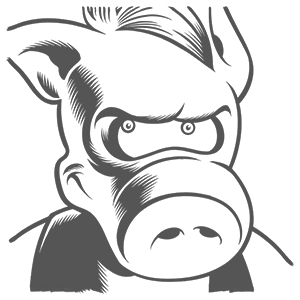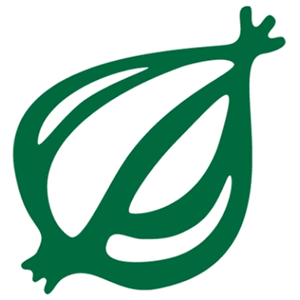‘Jockey Slut’ was a British music magazine that ran from 1993 to 2004, starting as a bi-monthly fanzine focused on dance music and club culture before becoming a monthly publication in 1999 following acquisition by Swinstead Publishing. The magazine distinguished itself through music-centered coverage that balanced witty fanzine-style writing with irreverent humor, giving early coverage to influential acts like The Chemical Brothers, Daft Punk, and The Streets, while also featuring rock and indie music. Its readers tended to refer to the magazine as just ‘The Slut.’
After transitioning to a quarterly format with increased online presence in 2004, the magazine closed in May of that year, leaving behind a legacy of being one of the first publications to feature interviews with many now-legendary electronic music artists.
read more »
Jockey Slut
El Paquete Semanal
El Paquete Semanal (‘The Weekly Package’) or ‘El Paquete’ is a one terabyte collection of digital material distributed since around 2008 on the underground market in Cuba as a substitute for broadband Internet. Since 2015, it has been the primary source of entertainment for millions of Cubans, as Internet in Cuba has been suppressed for many years. El Paquete Semanal has its own page that is running in the United States, where one could view its contents and is consistently updated every week.
The Cuban Government has also been investing in more internet access for the people, with the use of ETECSA, a service that the citizens could pay 1 CUC (equivalent to an American Dollar) for one hour of internet use. This has become the most popular method for people to become connected to the internet, mainly used to connect to social media, such as Facebook.
read more »
Zine
A zine [zeen] (short for magazine or fanzine) is a small-circulation self-published work of original or appropriated texts and images, usually reproduced via a copy machine. A fanzine (blend of fan and magazine) is a non-professional and non-official publication produced by enthusiasts of a particular cultural phenomenon (such as a literary or musical genre) for the pleasure of others who share their interest.
The term ‘zine’ was coined in an 1940 science fiction fanzine by Russ Chauvenet and popularized within science fiction fandom, entering the Oxford English Dictionary in 1949. Zines have served as a medium for various subcultures, and frequently draw inspiration from a DIY ethos that disregards traditional publishing conventions.
read more »
Alternative Newspaper
An alternative newspaper is a type of newspaper that eschews comprehensive coverage of general news in favor of stylized reporting, opinionated reviews and columns, investigations into edgy topics, and magazine-style feature stories highlighting local people and culture.
Its news coverage is more locally focused and their target audiences younger than those of daily newspapers. Typically, alternative newspapers are published in tabloid format and printed on newsprint. Most metropolitan areas of the United States and Canada are home to at least one alternative paper.
read more »
Army Man
‘Army Man‘ (tagline: ‘America’s Only Magazine’) was a short-lived comedy magazine published in the late 1980s by George Meyer, the acclaimed writer for ‘The Simpsons.’ The magazine consisted mostly of very short and very surreal jokes, along with some cartoons. Each issue also featured Jack Handey’s ‘Deep Thoughts,’ as well as other pieces written by him. Only three issues were ever published. Although Army Man was never widely distributed, it gathered a lot of attention in the comedy world.
Two of its writers (John Swartzwelder and Jon Vitti) were picked up alongside Meyer to be part of the original writing staff of ‘The Simpsons’ by the show’s developer and show-runner Sam Simon, an enormous fan of the magazine. Eventually other ‘Army Man’ writers would go on to write for ‘The Simpsons’ in later seasons. The writers were usually people Meyer knew from his years at the ‘Harvard Lampoon’ or who worked with him in TV shows like ‘Late Night with David Letterman,’ ‘The New Show,’ ‘Not Necessarily The News,’ and ‘Saturday Night Live.’
Not Brand Echh
Not Brand Echh was a satiric comic book series published by Marvel Comics that parodied its own superhero stories as well as those of other comics publishers. Running for 13 issues from 1967 to 1969, it included among its contributors such notable writers and artists as Stan Lee, Jack Kirby, Gene Colan, Bill Everett, John and Marie Severin, and Roy Thomas.
With issue #9, it became a 68-page, 25¢ ‘giant,’ relative to the typical 12¢ comics of the times. Its mascot, ‘Forbush Man,’ introduced in the first issue, was a superhero wannabe with no superpowers and a costume of red long johns emblazoned with the letter ‘F’ and a cooking pot, with eye-holes, covering his never-revealed head. His secret identity was eventually revealed in issue #5 (Dec. 1967) as Irving Forbush, Marvel’s fictitious office gofer.
read more »
The Realist
The Realist was a pioneering magazine of ‘social-political-religious criticism and satire, ‘intended as a hybrid of a grown-ups version of ‘Mad’ and Lyle Stuart’s anti-censorship monthly ‘The Independent.’ Edited and published by journalist and stand-up comedian Paul Krassner, and often regarded as a milestone in the American underground or countercultural press of the mid-20th century, it was a nationally-distributed newsstand publication as early as 1959.
Publication was discontinued in 2001. First published in the spring of 1958 in New York City in the offices of ‘Mad,’ ‘The Realist’ appeared on a fairly regular schedule during the 1960s and then on an irregular schedule after the early 1970s. In 1984, it was revived as a much smaller newsletter. Articles and cartoons from the magazine were collected in a book, ‘The Best of the Realist.’
read more »
2600: The Hacker Quarterly
2600: The Hacker Quarterly is an American publication that specializes in publishing technical information on a variety of subjects including telephone switching systems, Internet protocols and services, as well as general news concerning the computer ‘underground’ and left wing, and sometimes (but not recently), anarchist issues.
The magazine’s name comes from the phreaker discovery in the 1960s that the transmission of a 2600 hertz tone (which could be produced perfectly with a plastic toy whistle given away free with Cap’n Crunch cereal—discovered by friends of John Draper) over a long-distance trunk connection gained access to ‘operator mode’ and allowed the user to explore aspects of the telephone system that were not otherwise accessible.
read more »
Adbusters
The Adbusters Media Foundation is a Canadian-based not-for-profit, anti-consumerist, pro-environment organization founded in 1989 by Kalle Lasn and Bill Schmalz in Vancouver. Adbusters describes itself as ‘a global network of artists, activists, writers, pranksters, students, educators and entrepreneurs who want to advance the new social activist movement of the information age.’
Characterized by some as anti-capitalist or opposed to capitalism, it publishes the reader-supported, advertising-free ‘Adbusters,’ an activist magazine with an international circulation of 120,000 devoted to challenging consumerism. Adbusters has launched numerous international campaigns, including ‘Buy Nothing Day,’ ‘TV Turnoff Week,’ and ‘Occupy Wall Street,’ and is known for their ‘subvertisements’ that spoof popular advertisements.
read more »
The Wilson Quarterly
The Wilson Quarterly is a magazine published by the Woodrow Wilson International Center for Scholars in Washington, D.C. The magazine was founded in 1976 by journalist Peter Braestrup and James H. Billington, the thirteenth Librarian of the United States Congress. The ‘Quarterly’ is noted for its nonpartisan, nonideological approach to current issues, with articles written from various perspectives.
Designed to make the research and debates of scholars and intellectuals accessible to a general audience, it covers a wide range of topics, from science policy and literature to foreign affairs. In 2012, the ‘Quarterly’ changed to a digital-only publishing model.
read more »
The Believer
The Believer is a United States literary magazine that also covers other arts and general culture. Founded and designed in 2003 by the writer and publisher Dave Eggers of McSweeney’s Publishing, it is edited by novelists Vendela Vida and Heidi Julavits, along with’Village Voice’ editor Ed Park. The magazine is published in San Francisco nine times a year. Eggers and his cohorts initially planned to ‘focus on writers and books we like,’ with a nod to ‘the concept of the inherent Good.’
The magazine urges readers and writers to ‘reach beyond their usual notions of what is accessible or possible.’ Illustrations and cartoons are featured throughout the magazine. The cover illustrations are done by Charles Burns, while most of the other portraits and line drawings are by Tony Millionaire (following Gilbert Hernandez from the fifth issue on). Michael Kupperman’s ‘Four-Color Comics’ has appeared in many issues, and in most issues a series of images from a given artist or other source run throughout the articles à la ‘The New Yorker.’
The Onion
The Onion is an American news satire organization. It is a newspaper and a website featuring satirical articles reporting on international, national, and local news, in addition to a non-satirical entertainment section known as The A.V. Club (which features interviews and reviews of various newly released media, as well as other weekly features). Since 2007, the organization has been publishing satirical news audios and videos online, as the ‘Onion News Network.’
The Onion’s articles comment on current events, both real and fictional. It parodies such traditional newspaper features as editorials, man-on-the-street interviews, and stock quotes on a traditional newspaper layout with an AP-style editorial voice. Much of its humor depends on presenting everyday events as newsworthy and by playing on commonly used phrases, as in the headline ‘Drugs Win Drug War.’
read more »
